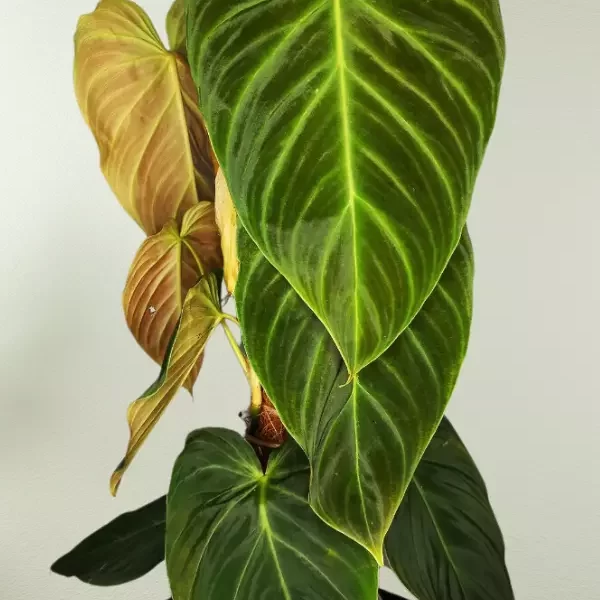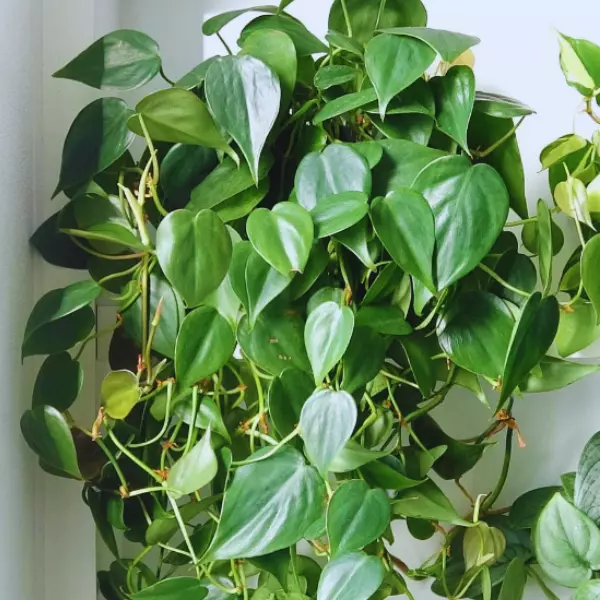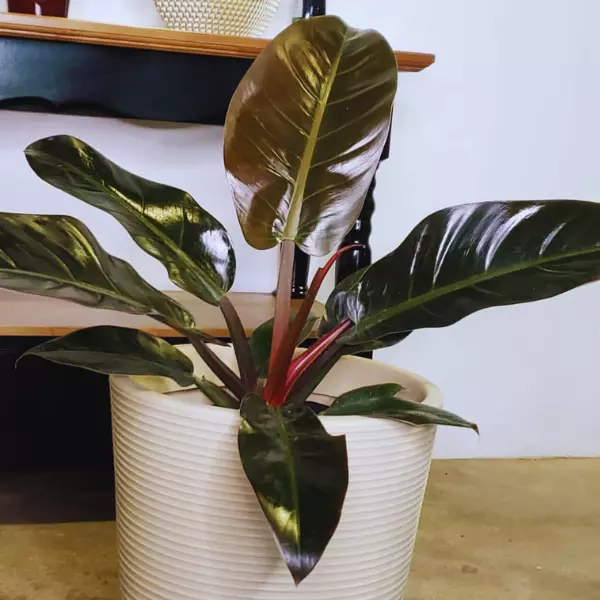Hello dear gardeners, there are so many indoor exquisite indoor plants, and Alocasia Nebula is one of them. Various Alocasia species like Pink Dragon and Azlanii are popular and adored by plant parents; however, many argue that Alocasia Nebula is the prettiest of all. Alocasia Nebula’s exact origin is unknown; however, it is believed to have originated from Northwestern parts of Malaysia. In the middle of the 1990s, Peter Boyce, Josef Bogner, and Alistair Hay noticed it growing there.
Allied Species: Alocasia Sarian, Alocasia Pink Dragon, Alocasia Lauterbachiana, Alocasia Silver Dragon, Alocasia Stingray, Alocasia Nebula, Alocasia Polly, Alocasia Tiny Dancer, Alocasia Dark Star, Alocasia Portora, Alocasia Cuprea, Alocasia Maharani
Related Products:
Habitat & Ecology
The rainforests of Asia and Australia are home to the Nebula Alocasia. This plant has several names, such as ‘African Masks’, the ‘Elephant-ear plants‘, the Silver Plant and Alocasia Silver Nebula. People grow this plant for its exquisite beauty.
| Botanical Name: | Alocasia Nebula Imperialis |
| Family Name: | Araceae |
| Common names: | Alocasia Silver Nebula, African Masks, Silver Plant |
| Plant type: | Perennial plant |
| Origin: | Northwestern parts of Malaysia |
| Humidity: | 65%. |
| Temperature: | 60°F to 80°F |
| Light Need | Bright, indirect light |
Alocasia Nebula Care Guide
The Alocasia nebula is a rare and no doubt a high-maintenance plant, but it will reward your care with its beautiful appearance and glossy green leaves. It is the most alien-looking indoor plant you will ever have, and its care could be challenging, but we have your back. We’ll guide you thoroughly so that you’ll be able to grow it at your home.


Growth
Nebula Alocasia has dark green leaves, heart-shaped and glossy with patterned venation that gives this plant a distinctive and sparkling appearance. As the leaves develop, they change from green to a silvery grey hue with veins that ranges from dark grey to charcoal. This plant already has an exotic appearance because of the distinctively silvery hue of its thick leaves.
These plants are more likely to expand if you properly care for them. You can anticipate a new leaf every week in the summer.
Alocasia Nebula is rhizomatous in structure, and several stalks with heart-shaped leaves emerge from the bulb (one leaf per stem). The flowers on Nebula are small and unattractive, just like those on other Alocasias. If you are a flower lover, then this plant isn’t for you.
Keep reading this article; we are going to guide you on how you can take care of your beautiful Alocasia Nebula plant.

Initial care of Alocasia Nebula at Home
Due to its unmatched aesthetic and sculptural appeal, the Alocasia Nebula is a growingly popular addition to indoor plant collections. After buying this plant, firstly, you should place it where direct sunlight will not hit it.
We recommend checking the soil’s moisture content before watering the plant for the first time. Furthermore, the nurseries and plant shops compact the soil for shipment to avoid moving during transport. Therefore, please aerate the soil before watering to improve the drainage. Routine maintenance is another essential thing that will help your plant to grow more quickly.
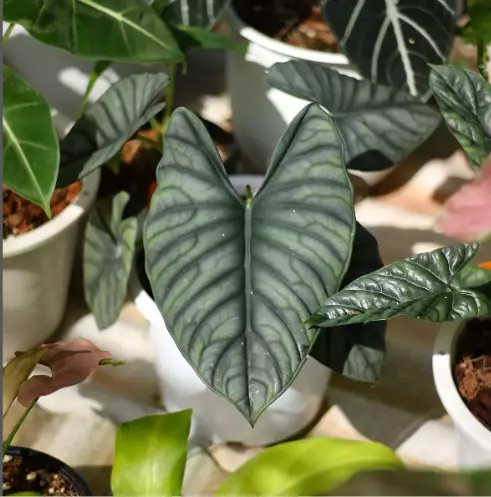

How often should I water Alocasia Silver Nebula?
Alocasia nebula requires comparatively less water to grow. Partially semi-moist soil is an ideal environment for Nebula to grow. Partially moist soil means it is not wet or dry. The soil should be moist but not soggy. Before you water the plant again, wait for the soil to drain and become partially dry. You shall check the top one inch of soil for dryness by feeling or using a moisture meter.
Water requirements for Alocasia Nebula change as the season change. Watering Nebula three times a week during the growing seasons of spring and summer is ideal, while you can decrease it to twice a week in the winters.
It is essential to ensure the soil does not get overwatering, soggy and wet feet because it can lead to health problems like root rot. We recommend not to water this sensitive plant with tap water. Rainwater is the best option; however, in case of nonavailability, you may use distilled or filtered water.

Light Requirements:
This plant requires bright but indirect sunlight. Keeping it in direct sunlight will cause significant issues like scorching of leaves. Alocasia Nebula leaves are so delicate that they are likely to get sunburn, and you obviously would not want their leaves to burn as the leaves are the plant’s main attraction.
Keeping it in partial shade is also ideal for this plant. The optimum location will be a few feet away from a window that faces east or west, where the plant receives plenty of indirect sunlight. However, never put this gorgeous plant in dark places.

Alocasia Nebula can tolerate the mild early morning and early evening sunshine. Alocasia can also be grown indoors with artificial grow lights. Since LED lights are so effective and environmentally benign, we always advise using them for plants.

Humidity and Temperature Requirements:
All the types of Alocasias plants love humidity, and so do Nebulas. The ideal humidity for Alocasia Nebula is at least 65 percent moisture in the air. You can use a humidifier to maintain the humidity level or put a pebble water tray under your pot. Grouping the Nebula with other humidity-loving plants is another thing you can do to maintain the humidity.
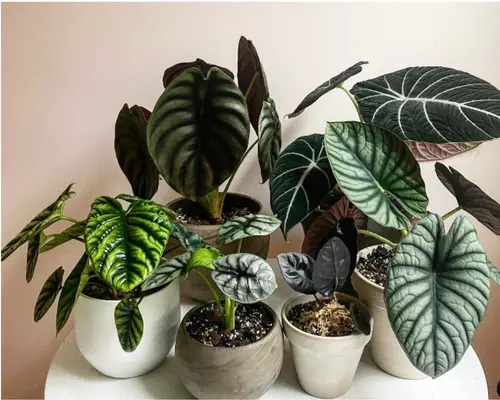
Alocasia Silver Nebula is a subtropical plant that requires warmer temperatures as it is in its natural habitat. 60°F to 80°F will be an ideal temperature range for your Alocasia Silver Nebula. Make sure to bring your Alocasia Silver Nebula back inside long before the temperature drops below 50°F if you keep it outside on a patio or other outdoor space during summer.
Fluctuations in the temperature can cause damage to the leaves. Remember that the Alocasia Silver Nebula can hibernate during the cooler seasons. They won’t necessarily lose all their leaves, but they will stop growing, so you need to keep them at a higher temperature to enjoy them.

Soil Requirements:
When choosing the proportions of soil in your soil mix, it’s crucial to remember that Alocasias have rhizomes and tubers in their root systems. You should combine one part of regular Potting soil, one part of peat moss, and one part of Perlite for Alocasia Nebula.
Peat moss possesses excellent moisture retaining properties and will help in keeping the roots hydrated. You may use Coco coir instead of peat moss as it will also add nutrient value to the soil. In contrast, Perlite will maintain the soil well-aerated, draining and loose, allowing the roots to expand.
The soil mix shall be able to drain effectively, and if the soil feels too dense, you can always add more perlite. To further enhance drainage, you can place a few pebbles at the pot’s bottom.
The PH level that is suitable for Alocasia Nebula is slightly acidic. It should be around 5.5 and 6.5. You can add lime to slightly increase the PH level of your soil and adjust it according to the plant’s needs.

Repotting:
There is no need for repotting unless the roots get congested, and pots get small for the plant. Similarly, if roots are coming out of the drainage holes, this is your sign to repot. Repotting is not that difficult; you just need to be delicate with the plant, so it doesn’t get damaged while repotting.
Signs of Root bound of Alocasia Nebula
If you are confused about when your nebula plant needs repotting, then keep reading this article; we will share some signs telling you that your elephant ear plant needs repotting.
Steps to repot Alocasia Nebula:

Propagation:
In simple words, propagation is the multiplication of plants. This can be done by different methods such as division, cutting, layering, crafting etc. The technique you should use depends on the specie of plant and the required goals such as disease resistance, increased crop production, etc.
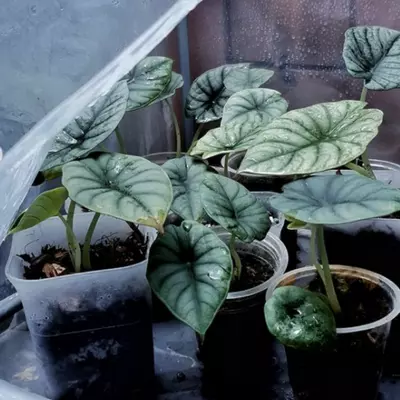
Propagation of the Alocasia Nebula is done by the roots division or stem cutting method. Whatever method you choose to propagate, ensure you do it during the spring or early summer. You can put the plant either in water or soil.
Stem Cutting Method
Division Method
The division is the most common propagation method for Alocasia Nebula. The right time to do the division propagation is the early summer season, so keep this in mind.

Fertilizer
You can fertilize this plant with appropriate care, as Alocasia Silver Nebula is a sensitive plant, and fertilizers can burn its leaves quickly. You can add diluted balanced houseplant liquid fertilizers after watering the plant.
Twice a month will be enough during the growing seasons, spring and summer. The plant turns dormant in winter and does not require fertilizer during winter.

Maintenance:
Maintenance of Nebula is a simple procedure and mostly requires cleaning and pruning only. When you understand what the right thing is to do. Cleaning should be done every week, and you should cut all the sick and discolored leaves so the appearance remains appealing and the plant’s resources are utilized to develop new growth.
Nebula’s leaves can grow a lot, and once it becomes bushy, you should prune them from time to time. Pruning will help new leaves to grow in a different direction, improving the appearance of your plant. Pruning can also allow Alocasia Nebula Imperialis to get denser or thicker. Just pay attention to Alocasia Nebula’s health and watering requirements, and then you will see the results of how beautifully it will grow.

Toxicity
You may be wondering if the Stingray on your Alocasia was toxic. In response to your inquiry, we can confirm that the Alocasia Stingray is, in fact, poisonous. We recommend keeping it out of the reach of both children and animals because of the potential for the plant to cause illness in case of consumption.
Unfortunately, both humans and animals can become sick from consuming your plant if they do so. Like many other Alocasia family members, Oxalate crystals can pierce tissues, leading to skin irritation, nausea, and abdominal pains. It is strongly advised that you keep your plant out of the reach of children and animals.

Pests Diseases & Common Problems
Despite how lovely this plant is, pests can damage it. Its delicate, fleshy leaves are a favorite food source for scale, spider mites, aphids, and mealybugs. So, it would help if you watched out for any of these issues. As soon as you see them, start treating them.
As the first attempt, use a water jet shower to wash away the pests. Then you can apply neem oil or insecticidal soap solution to prevent a recurrence. In case of a more severe attack and recurrence of infestation, please apply a suitable houseplant pesticide.
Bacterial leaf spot:
In this disease, some brown wet spots appear on leaves. This problem happens because of bacterial and fungal attacks on leaves. If you are thinking about treating this disease, then I have bad news for you: there is no treatment other than prevention. Damaged tissues cannot be cured, so removing these leaves and tissues is advisable as soon as possible. Furthermore, do not let water particles stay on leaves for long as these water particles trigger a fungal attack.
Root Rot:
Root rot is the most common disease that can happen to Alocasia Nebula. Your plant will gradually wilt, become yellow, and drop its leaves if the roots decay. A plant can be killed by root rot in a matter of days, and by the time you realize it, it’s often already too late. Repotting it sterile, controlling water intake, and more aerated soil may help you save your plant.
Common Problems in Alocasia Silver Nebula:
Alocasia Silver Nebula is a straightforward plant to grow if you provide your plant with enough and proper quantity of water and sunlight. The primary issue your plant can go through is the yellowing of leaves caused by overwatering. Water your Silver Nebula with the appropriate amount of water to avoid this issue. Provide your plant with enough sunlight, so these leaves stay healthy.
Another common issue is that Nebula leaves droop or wither because they receive too much or too little light or nutrients. Your plant will repay you with healthy leaves if you make the appropriate adjustments.
Frequently Asked Questions
Q. What artificial light is good for Alocasia Nebula?
Fluorescent light bulbs that emit the entire spectrum of wavelengths are the most excellent lighting source for indoor plants. They are ideal for indoor houseplants because they are frequently designated as “cool white” and don’t heat up.
Q. Why does Alocasia Nebula drop leaves?
When this plant is young, it drops off the leaf every single time a new leaf grows. Immature plants cannot maintain more than a few leaves; that’s why It starts shedding old and small leaves. It is because this plant is continuously expanding, and every week a new leaf grows on this plant.
Q. Why aren’t my Alocasia’s leaves expanding?
This typically indicates that the plant’s environment has too little humidity. They enjoy warm areas of your home but also require a specific amount of moisture. Some suggest misting the plant, which will probably be helpful in the short run but requires daily maintenance and may invite a fungal attack.
Q. Why is the growth of my Alocasia extremely slow?
Some plants take a break in the summer heat, but most, including Alocasias, go into dormancy in response to cold temperatures and diminished light. Alocasias develop leaves when it’s warm and sunny and slow down when the conditions are less favorable for growing. So, you must make the environment ideal for your Nebula plant, whether it is temperature, humidity, watering, or sunlight, so that they can grow quicker.
Final Words
Alocasia Silver Nebula is an excellent choice as your indoor plants. With its glossy green leaves and silver hue, this plant will make your drawing room, dining room, or whatever place it is in more exquisite.
Yes, it will require your attention and care like a baby, but isn’t it worth it? I am sure your guests wouldn’t stand back from praising the beauty of this prettiest jewel.
We hope this article will help you when you get this beautiful plant for your house; we would emphasize that you will get this beauty soon.
Happy Planting!!!
Related Posts
Philodendron Melanochrysum Care & Growing Guide
Philodendron ‘Splendid’ is a stunning hybrid of two stunning species of the Araceae family: Philodendron Melanochrysum and Verrucosum.
Philodendron Burle Marx Care & Propagation Guide
The most notable feature of the Philodendron Burle Marx is its large, glossy leaves, which come in heart-shaped or arrow-shaped variations.
Philodendron Scandens-“Sweetheart Plant” Easy Care Tips
Philodendron Scandens, often called the “Heartleaf Philodendron” or the “Sweetheart Plant” is a classic and most loved trailing houseplant.
Philodendron Erubescens ‘Imperial Red’ Care Tips
The Imperial Red Philodendron is easy to grow and can thrive well with little care and attention. Botanically known as Philodendron Erubescens.
Philodendron Ring of Fire Care & Growing Tips
Philodendron Ring of Fire is a striking plant known for its vibrant foliage and is believed a hybrid of Philodendron Wendlandii and P.Tortum.


